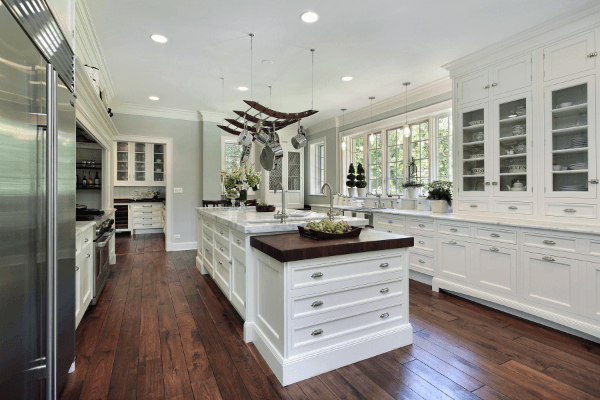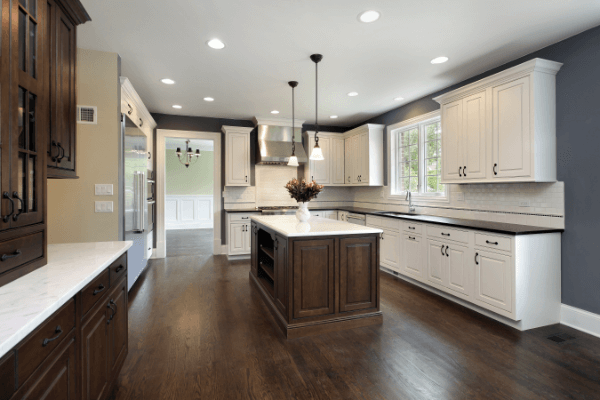Whether you are building a new home or renovating your kitchen, it is important to ensure the kitchen cabinets are properly installed. While DIYers can do it, you want to hire a professional for perfect work. Remember that not every kitchen cabinet is suitable for your home. Your kitchen design determines the type of cabinets you require. A kitchen remodeling expert can help you choose the right cabinets for your kitchen and budget.
Here is a list of some of the tools you require for the installation process:
- Screw gun or screwdriver set
- 4 ft. level
- Tape measure
- Screw clamps
- Countersink drill bit
- Drill driver
- Stud finder
- Jigsaw
- Chalk or light pencil
- Drill bit set
Other than the tools, make sure you have all the required materials e.g., shims and screws. Check whether there are any missing cabinet accessories. It is common for kitchen cabinets to come without stuff like doorknobs, toe-kicks, and drawer handles.

How Much Does It Cost To Install Kitchen Cabinets?
Several factors determine the cost of installing kitchen cabinets. Here are some of the things that determine the cost of kitchen cabinet installations:
- Material quality: The price of cabinets varies based on the materials used. Wooden cabinets are priced higher than laminate ones.
- Kitchen size: Is it a small or large-size kitchen? Of course, if your kitchen is big and you need elaborate cabinetry, you’ll have to spend more.
- Installation type: New installation costs less compared to remodeling. This is because remodeling involves the removal of old cabinetry and repairs.
- Labor: different contractors use different methods to charge for labor. Some charge per square foot while others base it on a percentage of the cost of materials.
6 Ways to Install Kitchen Cabinets
- Assemble the cabinets
If your cabinets are not assembled, check to see if there’s a guide on how to assemble them. Do not fix the doors because you will remove them together with the drawers to keep the cabinets light when hoisting them to the wall.
- Sketch a layout of the cabinets
A clear plan of how the cabinets will be arranged against the wall is crucial. The layout should not interfere with the electrical and plumbing system. The rule of thumb is to locate the highest point on the wall and start marking from the corners. Use the tape measure to get the dimensions. Move to the middle of the same wall and mark the highest point. Go to the place where the last upper cabinet should reach, and mark the highest point on the wall as well. Next, join the points to get a horizontal line. That’s the level where the upper cabinets will fall.

- Hang the upper cabinets
We always find it easy to start with the upper cabinets because it gives you enough space to move on the floor as you fix them. There’s space for your ladder too. If you are doing it alone, then you need a ledger to help hold the cabinets in place as you fix the screws. Use a stud finder to trace the studs in the wall.
Mark the stud locations using your pencil. Start hanging the cabinets from the corner as you move in the center. Ensure the top edge of the back panel lies on the horizontal line you drew. Once you perfectly fix the first cabinet, the rest will be easy for you.
Hang the second cabinet next to the first. Ensure its frame is aligned against the first, clamp them together, and screw the cabinet to the wall. Use the level to check if the two cabinets are in flush. Put shim between the wall and the back panels of the cabinets if the faces are not in plumb. Fix the next cabinet, if there is, following the same procedure.
- Install lower cabinets
Once you are done with the upper cabinets, fix the lower ones. Mark the studs again and begin fitting the cabinets the same way you did with the uppers. The upper and lower cabinets should be in flush. Cut openings for plumbing and electrical outlets.
- Install the countertop
With your cabinets perfectly installed, move to the countertop. Test it to see if it fits. Cut it to size if need be, and be careful when cutting to avoid chipping. Use a jigsaw to cut sink openings. Carefully screw the countertop into place using the right size of the screws.
- Fix the doors and drawers
The hinges should be fixed properly for the doors to close and open without applying a lot of force. If it was a remodeling project, reinstall any appliances you had removed.
We Deliver High-Quality, Reliable Services to Our Clients
If you consider installing new cabinets in your kitchen, please do not hesitate to contact us. Our team of kitchen remodeling experts is equipped with knowledge, skills, and tools to help you get your dream kitchen. You won’t regret hiring us because we provide high-quality services to our clients and our rates are easy on your pocket.
